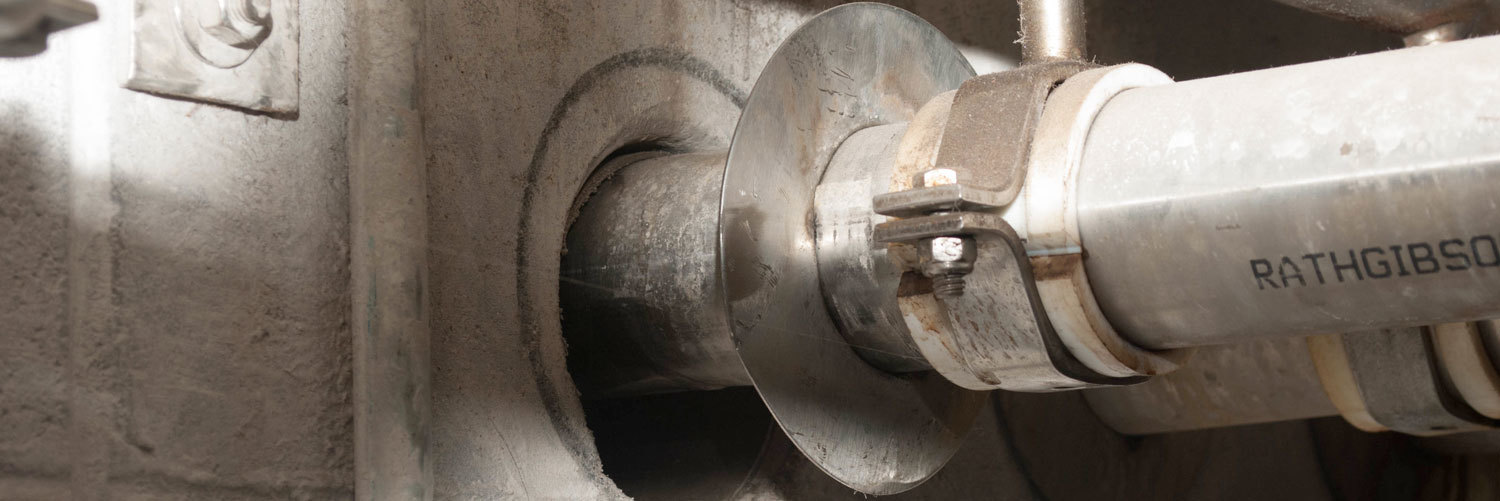A Guide to Wall Penetration eBook
in Processing Environments & Other Applications
Download PDF VersionSealing Strategies

Putties, Sealants, & Caulks
In process piping environments, these options are more of a temporary quick-fix than they are an actual sealing device. Their ability to conform to any shape in order to fill a void makes them a tempting choice to seal penetration gaps. However, putties, sealants, and caulks merely cover - they do not provide a legitimate seal around the piping surface. Their inability to remain pliable over time, their inability to withstand movement and vibration, and the mess associated with their application also makes them a poor choice.

Escutcheon Plates
For many years the traditional solution for covering piping penetrations in walls, floors and ceilings has been to use stainless steel escutcheon plates, also known as wall plates. They temporarily cover the gap in the opening and provide a decorative trim to the penetration. It is a common and inexpensive solution for covering gaps, but it has proven to be ineffective for most processing facilities.
Most escutcheon plates are installed by applying caulk or sealant to the back of the plate and pressing it against the barrier. They typically remain in position for a brief period until, over time, the caulk or sealant inevitably dries out and loses its adhesive qualities. Combined with the movement and vibration of process piping, the plate soon separates from the wall, exposes the gap it was meant to cover, and begins to slide down the piping.
Although escutcheon plates are relatively inexpensive and may be a short-term solution to covering piping penetrations, they do not provide a hygienic, permanent seal between the piping and the wall or ceiling. Their design can’t compensate for piping misalignment, pipe slope, movement or vibration.

Flexible Boots
An effective alternative to escutcheon plates is a type of sealing device that incorporates an elastomer boot to seal around the piping. The flexible boot can be trimmed to size in the field to maintain an air-tight seal around the piping. Unlike a rigid metal escutcheon plate, a flexible design maintains a secure seal around the piping despite pipe slope, misalignment, or movement. The elastomer boot also dampens piping vibration and absorbs noise.
Installation of flexible boot seals is much easier than escutcheon plates due to a self-sealing base that fastens securely to walls, floors and ceilings using a pre-drilled stainless steel mounting ring with screws. With this design there is no need for caulks or sealants, and with a mounted base the boot will not separate from the wall, floor or ceiling.
Modular Mechanical Seals
This seal design incorporates a series of elastomer segments or links that are bolted together to form a ring around the penetrant. The ring slides into the opening and, when tightened, expands to fill the gap. Modular mechanical seals are often used to provide a rigid, watertight seal around pipe penetrations in concrete foundations and structural openings where a hygienic seal is not required.
Each mechanical seal must be assembled using elastomer links, pressure plates and bolts. Some designs can offer fire-rated or pressure-rated options, but their non-hygienic design precludes them from use in food, dairy, beverage and pharmaceutical environments without being covered by an external seal designed for sanitary settings.
Once installed, the rigid design holds the piping securely and doesn’t allow movement. This feature is an advantage in some utility, drain or sewer applications, but it would create stresses in most process piping installations due to thermal expansion and contraction. If not allowed to flex slightly, piping is subject to material fatigue and potential failure in joints and connections.

